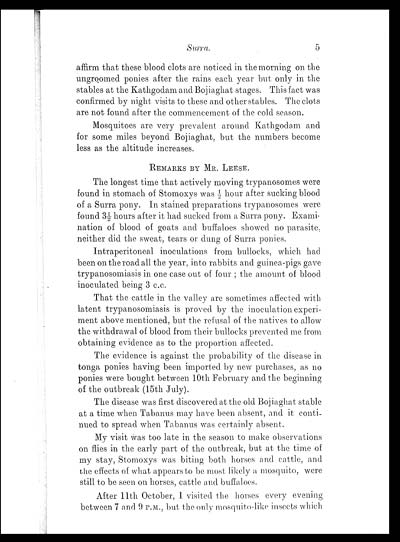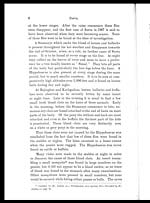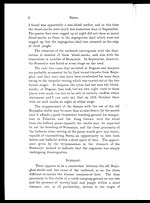Medicine - Veterinary > Civil Veterinary Departments > Indian Civil Veterinary Department memoirs > No. 1 - Report of the research work of the Imperial Bacteriological Laboratory Muktesar, 1908-09
(18) Page 5
Download files
Individual page:
Thumbnail gallery: Grid view | List view

Surra. 5
affirm that these blood clots are noticed in the morning on the
ungroomed ponies after the rains each year but only in the
stables at the Kathgodam and Bojiaghat stages. This fact was
confirmed by night visits to these and other stables. The clots
are not found after the commencement of the cold season.
Mosquitoes are very prevalent around Kathgodam and
for some miles beyond Bojiaghat, but the numbers become
less as the altitude increases.
REMARKS BY MR. LEESE.
The longest time that actively moving trypanosomes were
found in stomach of Stomoxys was ½ hour after sucking blood
of a Surra pony. In stained preparations trypanosomes were
found 3½ hours after it had sucked from a Surra pony. Exami-
nation of blood of goats and buffaloes showed no parasite,
neither did the sweat, tears or dung of Surra ponies.
Intraperitoneal inoculations from bullocks, which had
been on the road all the year, into rabbits and guinea-pigs gave
trypanosomiasis in one case out of four ; the amount of blood
inoculated being 3 c.c.
That the cattle in the valley are sometimes affected with
latent trypanosomiasis is proved by the inoculation experi-
ment above mentioned, but the refusal of the natives to allow
the withdrawal of blood from their bullocks prevented me from
obtaining evidence as to the proportion affected.
The evidence is against the probability of the disease in
tonga ponies having been imported by new purchases, as no
ponies were bought between 10th February and the beginning
of the outbreak (15th July).
The disease was first discovered at the old Bojiaghat stable
at a time when Tabanus may have been absent, and it conti-
nued to spread when Tabanus was certainly absent.
My visit was too late in the season to make observations
on flies in the early part of the outbreak, but at the time of
my stay, Stomoxys was biting both horses and cattle, and
the effects of what appears to be most likely a mosquito, were
still to be seen on horses, cattle and buffaloes.
After 11th October, I visited the horses every evening
between 7 and 9 P.M., but the only mosquito-like insects which
Set display mode to: Large image | Zoom image | Transcription
Images and transcriptions on this page, including medium image downloads, may be used under the Creative Commons Attribution 4.0 International Licence unless otherwise stated. ![]()
| Permanent URL | https://digital.nls.uk/75511834 |
|---|
| Shelfmark | IP/RA.10 |
|---|---|
| Additional NLS resources: | |




